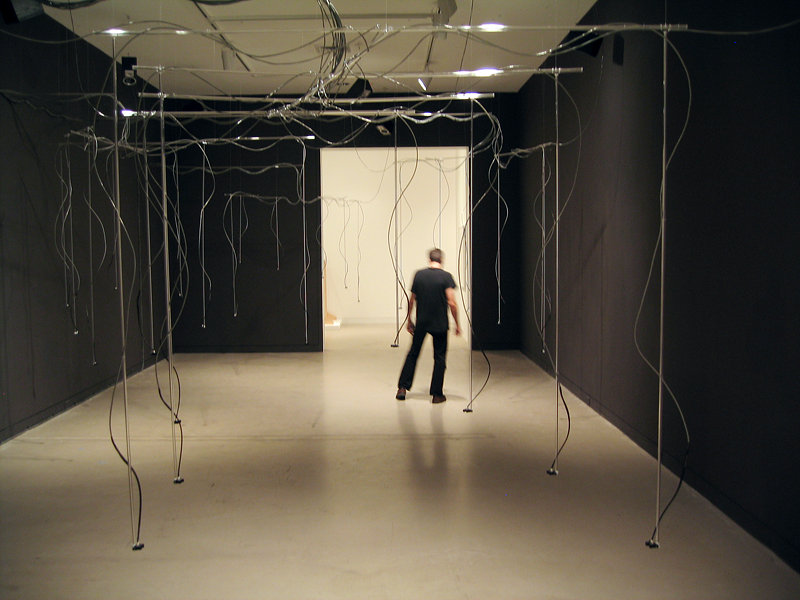California Biennial
Between Bodies / Tijuana:
A site specific, interactive sound installation by Nina Waisman
The Orange County Museum of Art, Orange County, CA
The first two images on the right show the finished version, followed by images of the piece in progress.
Video documentation:
Steve Schmidt walks through
filmed by Katherine Sweetman
Related writing
Fusing Bodies
Partial list of source sounds used in the piece
Partial Sound List
Some press:
digunag, Italy (English)
digimag, italy (Italian)
art21 review
http://www.kqed.org/arts/visualarts/article.jsp?essid=37459
artforum review
http://www.wired.com/underwire/2010/11/california-biennial/?pid=1906&pageid=52376&viewall=true
http://www.visualartsource.com/index.php?page=editorial&aID=670
http://www.ocweekly.com/2010-11-18/culture/california-biennial-orange-county-museum-of-art/1/
http://www.artltdmag.com/downloads/2010CABiennialSupp.pdf
http://sandiego.modernluxury.com/style/art-smart-sd-rocks-ocma-california-biennial
http://www.newuniversity.org/2010/11/entertainment/2010-southern-california-biennial/
http://imoralist.blogspot.com/2010/10/ocmas-2010-california-biennial.html
http://www.kcet.org/socal/voices/blur-sharpen/media-arts-preview-october-21.html
http://theocartblog.typepad.com/the_oc_art_blog_contempor/
http://www.orangecounty.com/articles/biennial-9863-art-museum.html
Description
There is much that binds Orange County and Tijuana! Mass media’s portrayal of Tijuana, through a lens focused almost exclusively on sensational drug-cartel crimes, would suggest our only connection to the Tijuanenses is through fear. Yet many OC residents and/or their employees, have family living in Tijuana. Many low-priced electronics enjoyed in Orange County are made by people earning $10/day in Tijuana’s maquiladoras; families working in these maquiladoras cannot afford to eat properly or rent a home with a roof. Some US and internationally-owned companies making these electronics in Tijuana, dump toxic by-products there, poisoning the water, land and residents. Technologies enabling keyboard-punched orders for Tijuana-produced goods, further obscure the links between our lives and the Tijuana residents fulfilling those orders.
Between Bodies, in parallel and in contrast, uses technology to connect visitors’ gestures to everyday work and play sound-gestures, recorded throughout Tijuana, focusing on aspects of richly layered lives that are not being portrayed by mass media. The piece opens with sounds of labor (hammering, filing, typing, etc) to create a common-denominator of bodily and sonic experiences heard throughout Tijuana but also most anywhere in the world, sounds of bodily-gestures possibly engaged in by many visitors. A gestural dialog is set up between museum visitors and Tijuanenses, a dialog not dependent on knowledge of the city, thus one that might open the city to those who only know it through sensational reporting. The piece ends with sounds of surveillance, similarly heard worldwide.
In between, and woven throughout, are a range of broadly recognizable yet localizing sound-gestures, increasing in number as one advances through the piece. The piece can become an almost-musical dérive, connecting visitors to sonic bodies encountered throughout Tijuana. The sensing body’s role as Theremin, tuning a city, is here technologically enhanced - as visitors move towards and away from the sensors, sounds are shifted in pitch, volume, speed, etc.
Many Tijuanenses have a personal history with the sonic gestures heard in the piece, further elaborating the gestural-sonic dialogues they experience. While the piece may seem to offer non-residents a purely virtual tour of Tijuana, there is a potential for “gestural mirroring” in the work, complicating pure tourism. Neurologists have found that hearing the sound of another body performing an action can lead us to experience this same action in the brain and muscles. We don’t enact the gesture but nerve-clusters for producing the action fire, and muscles are primed to act. Neurologists link this mirroring system to a survival-driven need for empathic skills – when I hear you do something, I experience your state, and can sense viscerally how we might next interact.
Meanwhile, Rodolfo Llinas (NYU Neurosciences Chair) explains that our learned gestural skills - walking, typing, etc - play in our brains, even when we don’t move. Not all play at once, but a few play together at a time, randomly. Llinas’ research finds that the overlaying of these gestural tapes is the source of creative thought! New logics arise from interference between re-played memories of our motor-based actions. A new tech-gesture, then, is not a small thing.
To put this all together, hearing sounds of recorded bodies performing actions can lead listeners to "mirror" the heard gestures. These mirrored gestures, overlaid with whatever gestural tapes are already playing in a listener’s brain, can lead to new, affiliated logics. Adding to this common, gestural pile-up, visitors to my installations employ new tech-controlling gestures to manipulate gestural sounds heard in the space. This logic-forming, gesturally mashed-up medium is worth considering, given our increasing use of physical computing devices, surveillance systems, and mediated sound. My work asks experientially: how might tech-inflected gestures shape the logic of our relationships with bodies and systems we connect to.
California Biennial: October 24, 2010 - March 13, 2011
Orange County Museum of Art
850 San Clemente Drive
Newport Beach, CA
more info here:
http://www.ocma.net/index.html?page=past&show=exhibit&e_id=3126
Artists in the California Biennial:
David Adey, Agitprop, Gil Blank, Nate Boyce, Luke Butler, Juan Capistran, Zoe Crosher, Brian Dick, Dru Donovan, Mari Eastman, Electronic Disturbance Theater/b.a.n.g. lab, Carlee Fernandez, Finishing School, Eve Fowler, Rebecca Goldfarb, Katy Grannan, Alexandra Grant, Sherin Guirguis, Drew Heitzler, Violet Hopkins, Alex Israel, Glenna Jennings, Barry MacGregor Johnston, Vishal Jugdeo, Stanya Kahn, Andy Kolar, Jennifer Locke, Los Angeles Urban Rangers, Tom Mueske, Tucker Nichols, Camilo Ontiveros, Nikki Pressley, Andy Ralph, Will Rogan, Paul Schiek, Taravat Talepasand, Wu Tsang, Zlatan Vukosavljevic, Nina Waisman, Flora Wiegmann, Allison Wiese, Lisa Williamson, David Wilson, Patrick Wilson, John Zurier.
The 2010 California Biennial is organized by the Orange County Museum of Art and curated by Sarah Bancroft, OCMA curator.

Photo courtesy of Joshua White; Courtesy of the Orange County Museum of Art, Newport Beach, CA

Photo courtesy of Joshua White; Courtesy of the Orange County Museum of Art, Newport Beach, CA

Photo: Nina Waisman

Photo: Megan Flannigan

Photo: Nina Waisman